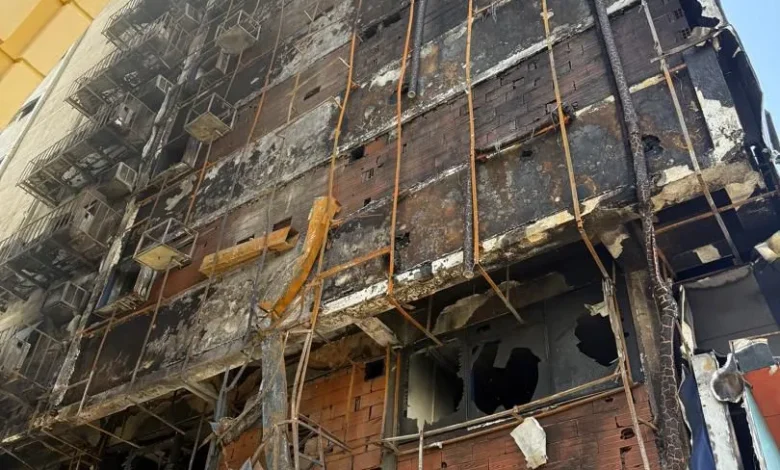The Director-General of the Nigeria Centre for Disease Control and Prevention (NCDC), Jide Idris, recently sat with PREMIUM TIMES to discuss the outbreaks of Lassa Fever, Mpox, Meningitis and other infectious diseases, the factors contributing to their persistent spread, and the country’s vaccine challenges.
Here’s an excerpt of the discussion
PT: During the last NCDC press conference in 2024, you mentioned a seasonal surge in Lassa Fever transmission attributed to climate change. Can you explain this further?
Mr Idris: As I said last year, many factors contribute to the rise of Lassa Fever. However, climate change is a key contributor, further compounding the situation. If you look at how Lassa Fever is transmitted, we can see its influence. The disease is transmitted by a particular rat, common in some parts of the country, and that’s why you have the hot spots.
Basically, the Lassa Fever virus itself is found in these animals. We call them the reservoirs. The infected animals may not show any signs of illness; however, they can transmit it to other people, especially when they come into contact with them. Most often, this occurs during the dry season, when it’s hot. When the activities of this rat increase, it could be when they are looking for food or when they’re not.
The influence of climate change occurs in the hot seasons. Typically, during this season, farmers start clearing bushes, and a process of deforestation kicks off. However, people, without knowing it, are destroying the natural habitats of these rats. And so, they are displaced, making it compulsory for them to look for places to hide. Often, the rats find solace in people’s homes, especially houses located near their habitat.
When rainfall delays or there’s a shortfall, as we have seen in parts of the country, it prolongs the window for human–rat contact, contributing to a rise in new cases during the dry season. As we know, delayed rainfall and droughts have been attributed to climate change.
Nigerians need credible journalism. Help us report it.
Support journalism driven by facts, created by Nigerians for Nigerians. Our thorough, researched reporting relies on the support of readers like you.
Help us maintain free and accessible news for all with a small donation.
Every contribution guarantees that we can keep delivering important stories —no paywalls, just quality journalism.
The rodent-to-human contact sometimes happens through food or agricultural products already exposed to the animals. While loitering in human houses, rats can drop droppings in the food, which could be faeces or saliva.
Lassa Fever is an animal disease. It is called a zoonotic disease because it can spread to humans through contact. So, if any human being comes into contact with rats, the virus can spread.
PT: When exactly does infection heighten?
Mr Idris: The disease peaks between December and May, so we are in the season right now. That’s why it’s always good to start alerting people months before this season.
PT: How exactly does rodent-to-human transmission occur?
Mr Idris: A major factor is the farmers’ agricultural practices. Those who farm grains, like guinea corn and maize. These grains are spread out to dry. And the rats, in the process of eating, drop their faeces or urine, or saliva on the grains. When people consume this without cooking properly, they get infected.
Poor sanitation also aids transmission. When rats come, they look for areas with poor sanitation—sanitation in the sense that waste disposal is not properly done. Communities with unsanitary waste disposal systems are more likely to have rats invade homes and contaminate food items.
PT: How can people vulnerable to the disease prevent infection?
Mr Idris: One of the easiest ways to avoid infection from contact is to cultivate a culture of hand washing. When you touch any food or a disposable item, it is always good to wash your hands with soap and water. At least if you have any of those droppings on your hands, once you can wash them with soap and water, you will be clean. It also means you can’t transmit to other people. That’s why hygiene is very important.
Also, if your homes have leakages, like holes where rats can enter, try to block all openings. When the rodents have nowhere to go, they go back to their natural habitat.
PT: So, can we say Lassa fever is strictly seasonal?
Mr Idris: Ohh, that was before. There was a time when it was a seasonal disease. But now, we are beginning to see that it occurs throughout the year. But it has a peak season, which is the dry season, and as we have said earlier, the dry season might be extended for a longer period in parts of the country.
When we have drought, the rats’ natural habitat is destroyed even more, and they spend more time in homes, infecting food and establishing contact with humans. During the rainy season, the vegetation has grown, and they have cover. They know where they stay naturally during this period, and that’s why it is not common during the rainy season.
PT: Aside from Lassa Fever, what other infectious diseases are influenced by seasonal variations?
Mr Idris: Meningitis peaks during the hot season. Cholera is all year round. COVID is heightened during the cold season. Mpox is not so seasonal. Measles is all year round and mostly affects children. The flu is during the cold season. We are managing about eight outbreaks right now. The worst outbreak that we are dealing with right now is heavy metal poisoning, but we are still not sure what is causing it. We have this in Sokoto and Zamfara, and we are still studying the situation.
PT: Let’s revisit Lassa fever for a minute. We’ve had multiple outbreaks in recent years. Are there recurring patterns that are disturbing?
Mr Idris: Lassa Fever is a zoonotic disease. We deal with it under the One Health platform. This combines the efforts of health, environment, agriculture, and livestock agencies.
The environment people know what to do when it comes to sanitation. They notify the people of their responsibility. They tell people again how to dispose of their waste, how to cover their waste, and how to prevent rats from infecting them.
Now, those in charge of animals know that when it comes to rats, the reduction of the rodent population in hotspot communities, they know what to apply to reduce the population of rats.
They have various methods of decreasing the population of rats. But again, research-wise, there are different views on that because it is like an ecosystem. If we disturb one part of it, we might create another problem. It’s still a source of research.
Now, to your question. Poor personal and environmental hygiene remains a problem. If people can dispose of their waste properly and maintain good personal hygiene, like handwashing, they reduce the rate of transmission.
Also, Lassa Fever is treatable and presents in the normal ways most diseases present. But when it grows into hemorrhagic fever, people start bleeding. It becomes severe. Patients start bleeding and losing blood. They experience kidney failure and are at risk of death.
That is why we prioritised sensitising health care workers on symptoms. Once these symptoms are identified, the workers direct the patients to the facilities where they can be treated. But what we find is that people present themselves late to the healthcare facility. In many cases, the patients present themselves when the disease has worsened, or when it becomes very difficult to treat. Once you start losing blood and your kidney fails, very few facilities can treat you. It’s not all facilities that are equipped to treat severe Lassa Fever. That’s why, again, as part of our efforts, we supply dialysis machines to some tertiary facilities that can handle this.
PT: So, most of the deaths occurred among infected individuals who didn’t seek medical care early?
Mr Idris: Yes. Most of the people who have died presented late. This is why we keep saying, once you start noticing the signs, get yourself to the hospital. The doctors and health care workers know what to do. The idea is, get your treatment early enough to prevent complications.
PT: What age group is most affected?
Mr Idris: Lassa Fever affects everyone, but people between the ages of 18 – 45 are most vulnerable. This is because they are the most mobile group. The most active age group is the most vulnerable. Farmers and people who frequent farmlands are highly susceptible.
PT: For people in communities without functioning PHCs, how do they access care or ensure early detection?
Mr Idris: The NCDC has an existing partnership with the state and local governments. We work together with the local governments, and they know areas without facilities. What we do is work with them to ensure that they create some kind of system for those who do seek care in such areas. It is not the responsibility of the NCDC to do that. Our role is to support them, assist them, basically, in treating them.
So, one of the major things we do is public awareness and enlightenment. We do it nationally and also send some of these advisories to the state and local governments to replicate in their local languages for indigenous communities. The local authorities know the community structure and learn the best way to translate this to the community. Our role is to support them in terms of messages and advice.
If they need materials or facilities again, we will provide them, including training. We train their staff on how to disseminate this information and how to identify.
The idea is to support the government’s effort to ensure there’s a system in place in communities without functioning health facilities. It’s not only facilities that need to be maintained; there’s also a need for staff; you need to have people.
PT: Since the 1970s, when the first case of Mpox was reported, Nigeria has been free of the infectious disease. But in 2017, after nearly 50 years, a Clade II variant was detected in Bayelsa. What was the reason for the resurgence of the disease?
Mr Idris: Mpox is a funny disease. Like any disease, we are yet to understand its full epidemiology, but the research is ongoing. We are still trying to find out why it resurfaced and what is responsible for the spread. It is also considered a zoonotic disease, and it is gotten from monkeys. In some of the areas where it is endemic, studies have yet to confirm why it is so.
Those brought from neighbouring countries are also being researched, but nothing is confirmed or fully understood yet. You know, that’s why research is continuous: the study of disease, its occurrence, and spread.
Now, in terms of resurgence, before Nigeria reported its first case in 2017, other African countries, such as Eastern and East Africa, had started detecting cases. It could have been imported here from those countries. However, nothing is confirmed yet. We don’t know whether it is endemic in Nigeria or not. But the idea is, we must be able to stop it from coming in, and we should be able to detect it when it comes in.
PT: What measures are in place to protect border areas?
Mr Idris: Nigeria has the clade II variant, which is less dangerous, and we are working to control the spread. However, next door, Cameroon has clade I, a more dangerous variant, and that is concerning. This is why we are sensitising all the states close to the border area. The Nigeria Ports Health Authority is also doing their own, especially with respect to people coming in. We are also galvanising internal responses about this to ensure early detection. This is so that people can easily pick it up early.
Also, we’ve done what we can as an agency: optimise the services of laboratories in those areas, particularly those that have the correct equipment and can detect the disease. A few of them are optimised to characterise using the latest genomic sequences.
PT: What factors contribute to the spread of Mpox in the country?
Mr Idris: As I said earlier, this is a zoonotic disease. It is an infection transmitted by animals and is likely to be endemic in places where those animals reside. Again, it’s also related to the agricultural practices of hunters—that is, people who hunt food and meat, and also people who work with animals.
Such animals are a primary source of contact, particularly those that are infected. Again, increased awareness is important. The groups vulnerable to this must ensure that they adopt good agricultural practices, including those who hunt bushmeat. And you know, bushmeat can be rats, monkeys, and all sorts of things.
PT: So, are you insinuating that there are people in Nigeria who got Mpox directly from the monkeys?
Mr Idris: We don’t know yet. We don’t know which animal is infected. The idea is to assume the possible implications, especially in those areas where you have monkeys.
Those are the people who might be at risk, who can carry this and spread it further if they’re infected with monkeypox. We’ve not linked any right now, but monkeys are supposed to be reservoirs of these diseases. It’s a high suspicion.
PT: Although children are most susceptible to the disease, there are no Mpox vaccines for them. What methods are adopted to protect them and treat them when infected?
Mr Idris: Well, you cannot use vaccines for everything. If there are vaccines and people get vaccinated, it is good. That’s why the childhood immunisation is essential. Also, not all vaccines can give a lifetime of protection. Protection may be short-lived.
That’s why, again, you don’t rely on vaccines alone. If you look at the mode of spread of this disease, you’ll realise you need to implement your control methods to address each mode of spread. To prevent a disease, you need to adopt the correct procedure. If you have the vaccines, it’s a plus because they give protection, even if just for a short period.
When we don’t have the vaccines, it is always helpful to adopt all the preventive measures necessary. And for most diseases, infection prevention and control are key. You can learn how to wash your hands with soap and water regularly, whether cooking, playing, painting, or using the bathroom. It reduces the chances of contracting communicable diseases by over 40 per cent. That’s why, again, we always have the IPC, which stands for infection prevention and control. It’s the basic things. It’s hygiene. If you get the food, cook it properly before you eat. When you are preparing the food, prepare it properly with clean hands.
For treatment, you just have to treat the skin rash properly, and the child will be fine. There are drugs that provide the treatment needed. But if that is not done early, the patient can end up with a superimposed bacterial infection, which is more serious.
However, no one has died of Mpox so far.
PT: How are disease outbreaks in IDP camps handled?
Mr Idris: IDP camps are inadequate. The camps are overcrowded, the sanitation is poor, and many diseases thrive in such places. Meningitis, Lassa Fever, Cholera and Mpox are some of the diseases that thrive in IDP camps.
As a result, these are key areas where support personnel should be present. There should be constant preparation for emergencies, especially for those that are recurring. For instance, flooding is an annual occurrence in some places. The state government should prepare ahead of time to ensure all essential services, including healthcare, that will be needed are provided. The NCDC is always preparing in terms of support, such as materials, personnel, and all that. The states should also develop their emergency preparedness capability because they cannot be totally dependent on the NCDC.
PT: Do you think sensitisation among this group is adequate?
Mr Idris: It is not adequate; hence, we need to do more as health is everybody’s business. The state and federal governments have to do more, particularly the state government, because the state is where most of these things occur. Also, the federal government has to help the state develop emergency preparedness capabilities.
PT: You mentioned earlier that meningitis, like Lassa Fever, peaks during the hot season. Can you explain this more?
Mr Idris: It is caused by a bacterium that thrives in the hot season. The bacteria thrive best when there is heat, and the way it spreads is different. That’s why the disease is high in settings with overcrowding. Anywhere you have mass gatherings, meningitis is likely to break out, and this affects both children and adults. Often, symptoms of the disease are characteristic, depending on the age. Zero-dose children, that is, children who are not immunised, are more susceptible to meningitis.
PT: What efforts are in place to curb the spread of diphtheria?
Mr Idris: Our main problem with diphtheria is the lack of vaccine. This is something that can easily be taken care of because it is part of the immunisation schedule. But many children here have not been immunised. Also, the vaccine is not available in the country. So, it is a vaccine issue here, and we are working with the Primary Healthcare Development Agency.
READ ALSO: Lassa Fever: Death toll rises to 127 NCDC
PT: Given the dissolution of USAID—an agency that has, over the years, played a crucial role in facilitating vaccine supply to Nigeria—does the NCDC anticipate any challenges in responding to future disease outbreaks?
Mr Idris: As a government, the earlier we stop relying on foreign assistance, the better for us. We need to take care of our situation here. We also have to understand that we can only properly take care of the situation here if our economy is right. So, this is a major problem.
I know that this present administration is doing all it can do within the economic conundrum to address this. That’s why, when the reduction was announced, the federal government quickly released some money to address some key areas of the health sector where this can bite harder.
Hopefully, the strategies developed by the Federal Ministry of Health will mitigate the impact. The ministry is focused on creating an environment where we can manufacture locally. If we start manufacturing face masks, PPEs and vaccines, we will be in a better position to respond properly. What we must do is build local capacity. Yes, it is going to take a while, but we must.
The funding is not going to be enough right now, but this is a lesson for us to start.
Support PREMIUM TIMES' journalism of integrity and credibility
At Premium Times, we firmly believe in the importance of high-quality journalism. Recognizing that not everyone can afford costly news subscriptions, we are dedicated to delivering meticulously researched, fact-checked news that remains freely accessible to all.
Whether you turn to Premium Times for daily updates, in-depth investigations into pressing national issues, or entertaining trending stories, we value your readership.
It’s essential to acknowledge that news production incurs expenses, and we take pride in never placing our stories behind a prohibitive paywall.
Would you consider supporting us with a modest contribution on a monthly basis to help maintain our commitment to free, accessible news?
TEXT AD: Call Willie - +2348098788999


















 English (US) ·
English (US) ·